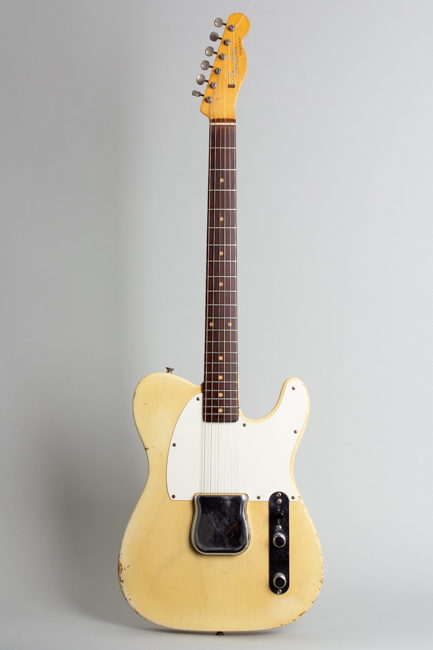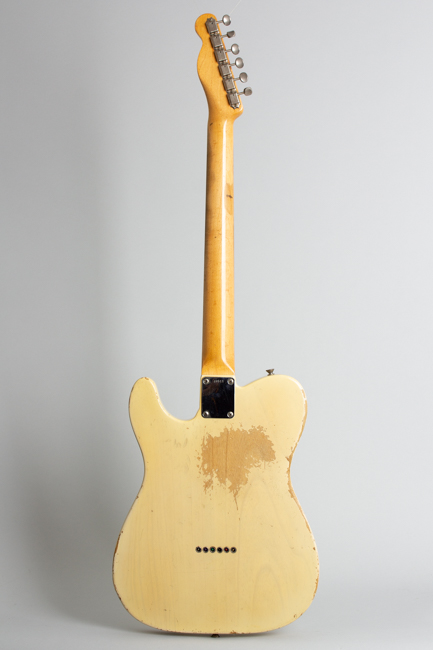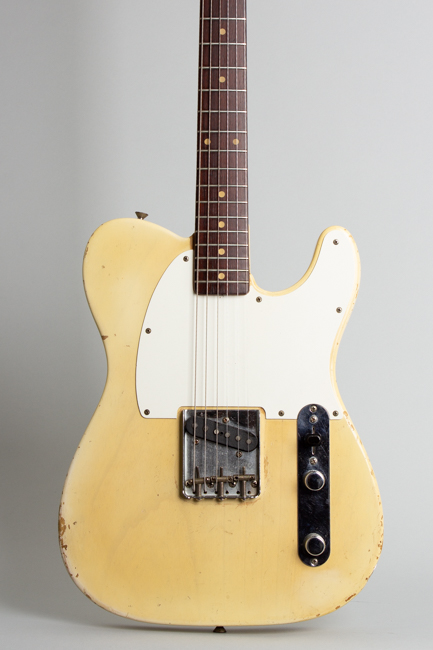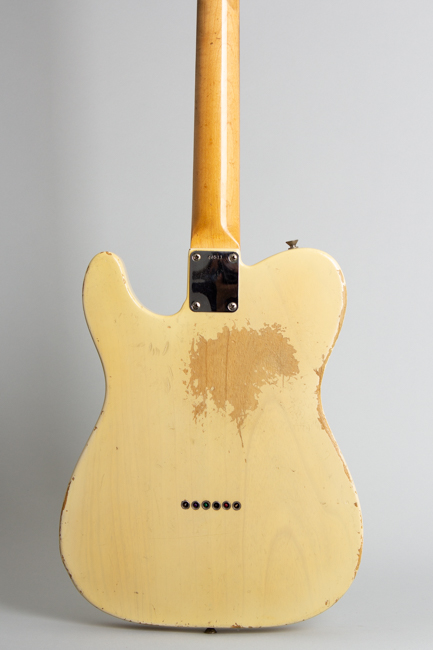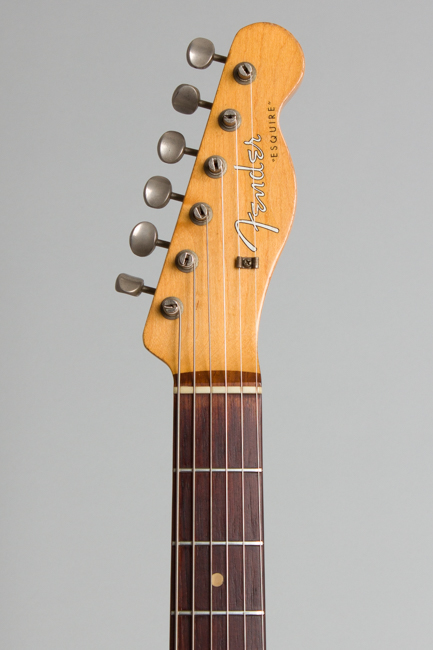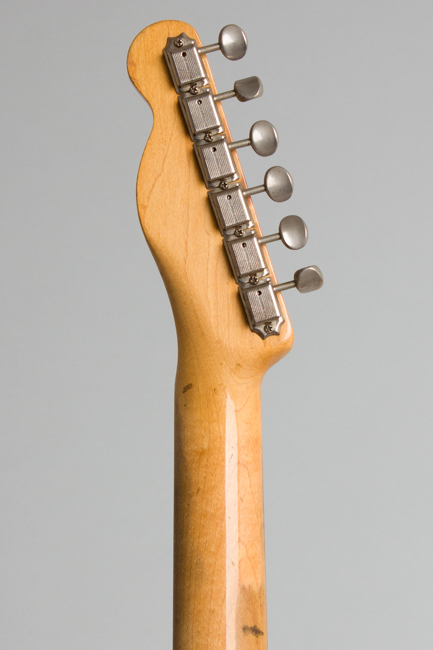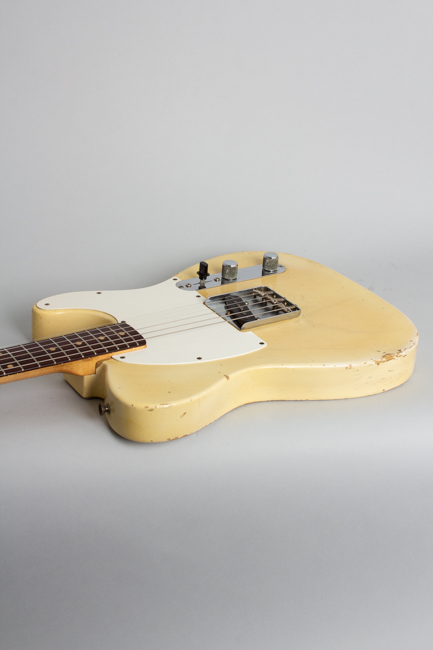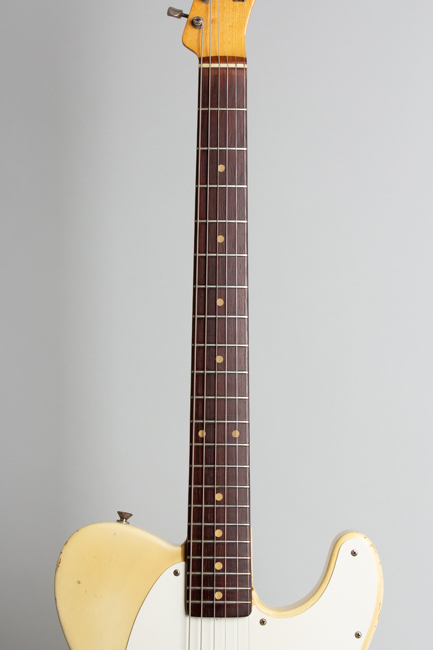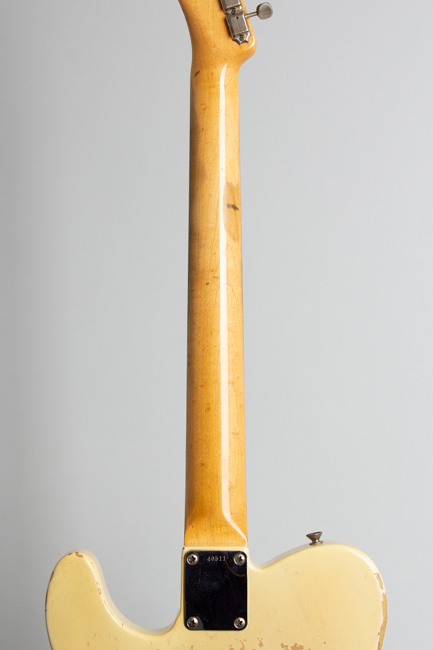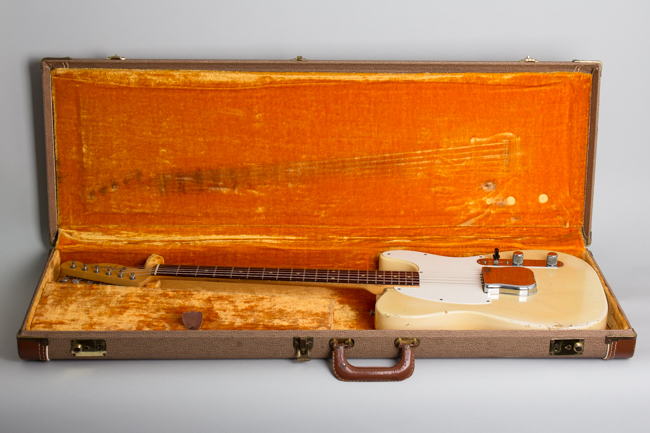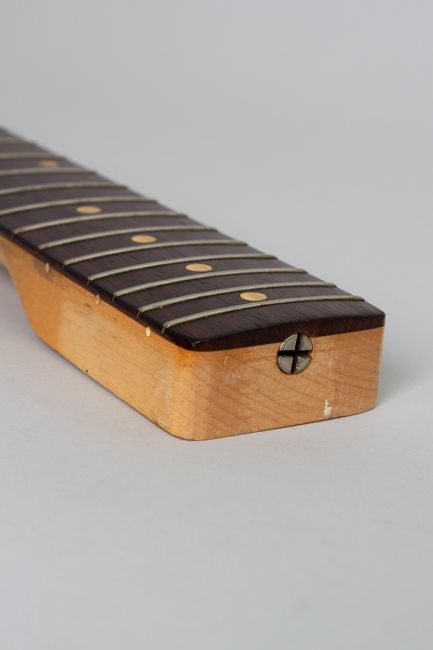Fender Esquire Solid Body Electric Guitar (1959)
This item has been sold.
Item # 10426
Prices subject to change without notice.
Fender Esquire Model Solid Body Electric Guitar (1959), made in Fullerton, California, serial # 40511, Blonde lacquer finish, ash body, maple neck with slab rosewood fingerboard, period brown hard shell case.
This is a somewhat worn-in but lovely original example of a 1959 Fender Esquire, one of the very first rosewood fingerboard examples. The features are a specific combination found only in this period. The neck is not date marked (as is correct for 1959) but the body is pencil dated 9/59 in the pickup rout and the pots are coded to the 47th week of 1958. Esquires from this period are quite rare. Even compared to Telecasters.
The "Esquire" name had been in use at Fender since 1950 for the single pickup variation of the Broadcaster/Telecaster, by the turn of the 1960s the model's popularity was waning. While cataloged as a separate instrument, The Esquire was assembled from all the same parts as the Telecaster allowing Fender sales to offer a slightly cheaper alternative for the buyer who couldn't spring for the Tele's $189.50 price tag.
By the time this one was made in fall 1959 sales of the Esquire were in steep decline, outpaced by newer Fullerton models both more expensive, like the Stratocaster and new Jazzmaster, and especially the lower-priced Duo-Sonic and Musicmaster. Fender's introduction of these budget-priced student guitars in 1956 cut heavily into the Esquire's sales territory, and the model began to languish. By the early-mid 1960's the Fender line had changed considerably, and the Esquire would pretty much get lost in the shuffle although not officially discontinued until 1970.
Starting in the summer of 1959 the original Fender one-piece maple neck was discontinued across the line in favor of the new "slab" rosewood fingerboard. This Esquire would be a very early example of this, with a fairly flat and slim profile in cross section typical of early slab board Fenders. The 5-digit serial number is stamped on the neck plate, and it had been since 1955.
The blonde finish is somewhat thicker and more translucent than earlier blonde Fender guitars. It is also a more "white-blonde' hue, though this one like most has yellowed a bit over time. The single layer white pickguard is secured by eight screws (up from 5) another change specific to 1959. This "blank" pickguard conceals the factory rout for the neck pickup, as the bodies used were exactly the same as for the Telecaster.
The Esquire control rig is unique, although externally the same as the Telecaster with standard knurled metal volume and tone knobs and 3-way switch with a "top hat" tip. The wiring is cleverly designed to offer three tonal options on a one-pickup guitar: #1 is a special bass-heavy setting, #2 engages a normal tone control function, and #3 is a "bypass" setting sending the signal straight to the jack. This last is the Esquire's secret bonus, offering some of the finest, snarliest tones ever to emerge from Fullerton.
As the 1950s progressed, the Esquire was ordered in ever-shrinking numbers, making it generally rarer than the same year Telecasters. This 1959 example has seen some use but remains unaltered in excellent playing and sounding condition. Amazingly the original purchase receipt is included, indicating the guitar was bought right here on New York's famous 48th Street in July 1960 by someone named Finn Engersen, along with a Vibrolux amp. He wrote the address (And phone number!) of Fender sales in Fullerton on an envelope from his hotel for reasons unknown. He then took his rig to Rio on the S.S Brazil (sailing August 5th) not long after, so this guitar has certainly had an interesting life so far! It rests in a period early brown Tolex Fender HSC, but which by the look of the internal marks a Stratocaster has lived in (less frequently!) as well. The well-worn original hang tag/instruction manual is still in the pocket.
Overall length is 38 3/4 in. (98.4 cm.), 12 3/4 in. (32.4 cm.) wide at lower bout, and 1 3/4 in. (4.4 cm.) in depth, measured at side of rim. Scale length is 25 1/2 in. (648 mm.). Width of nut is 1 5/8 in. (41 mm.)., 7.1 lbs.
This 62 year old Esquire shows some general play wear but remains beautifully original internally and externally. The original body finish has numerous smaller dings, dents and chips, mostly along the edges as is typical for slab-sided Teles and some random dings into the face. There is some typical belt-buckle wear to the back, and the edge wear is heaviest along the back rims. The hardware shows some light corrosion, with plating loss to the knob sides and minor corrosion on the steel bridge saddles.
The neck finish is relatively clean, with only light fingerboard wear and some lacquer rubbed down to the wood on the side edges. What looks to have been a deep ding on the bass side just past the third fret was lightly filled and topically finished over. The frets are original with probably one G&P in the past, and are extremely playable.
Everything else is original down to the screws and the snap-on bridge cover, which has some scuffing on the top. The adjustment screw on the lowest bridge saddle has been bent a bit to allow better intonation. The guitar remains original internally, having never had a neck pickup fitted as was once common. The single staggered-pole pickup and complex multi-capacitor Esquire wiring rig are original with untouched solder joints. The Fender Esquire decal on the headstock is well preserved with a couple of tiny flaked spots.
This old Esquire has survived just the way we love 'em; played in but well cared for, unaltered and ready for the next 60+ years. The sound is simply glorious, bright and snarly when cranked but still sweet and bell-like when the amp is backed down. This is one pure, under 7 LB. package of real, genuine unadulterated vintage 1950's Fender goodness in its simplest form. Excellent - Condition.
This is a somewhat worn-in but lovely original example of a 1959 Fender Esquire, one of the very first rosewood fingerboard examples. The features are a specific combination found only in this period. The neck is not date marked (as is correct for 1959) but the body is pencil dated 9/59 in the pickup rout and the pots are coded to the 47th week of 1958. Esquires from this period are quite rare. Even compared to Telecasters.
The "Esquire" name had been in use at Fender since 1950 for the single pickup variation of the Broadcaster/Telecaster, by the turn of the 1960s the model's popularity was waning. While cataloged as a separate instrument, The Esquire was assembled from all the same parts as the Telecaster allowing Fender sales to offer a slightly cheaper alternative for the buyer who couldn't spring for the Tele's $189.50 price tag.
By the time this one was made in fall 1959 sales of the Esquire were in steep decline, outpaced by newer Fullerton models both more expensive, like the Stratocaster and new Jazzmaster, and especially the lower-priced Duo-Sonic and Musicmaster. Fender's introduction of these budget-priced student guitars in 1956 cut heavily into the Esquire's sales territory, and the model began to languish. By the early-mid 1960's the Fender line had changed considerably, and the Esquire would pretty much get lost in the shuffle although not officially discontinued until 1970.
Starting in the summer of 1959 the original Fender one-piece maple neck was discontinued across the line in favor of the new "slab" rosewood fingerboard. This Esquire would be a very early example of this, with a fairly flat and slim profile in cross section typical of early slab board Fenders. The 5-digit serial number is stamped on the neck plate, and it had been since 1955.
The blonde finish is somewhat thicker and more translucent than earlier blonde Fender guitars. It is also a more "white-blonde' hue, though this one like most has yellowed a bit over time. The single layer white pickguard is secured by eight screws (up from 5) another change specific to 1959. This "blank" pickguard conceals the factory rout for the neck pickup, as the bodies used were exactly the same as for the Telecaster.
The Esquire control rig is unique, although externally the same as the Telecaster with standard knurled metal volume and tone knobs and 3-way switch with a "top hat" tip. The wiring is cleverly designed to offer three tonal options on a one-pickup guitar: #1 is a special bass-heavy setting, #2 engages a normal tone control function, and #3 is a "bypass" setting sending the signal straight to the jack. This last is the Esquire's secret bonus, offering some of the finest, snarliest tones ever to emerge from Fullerton.
As the 1950s progressed, the Esquire was ordered in ever-shrinking numbers, making it generally rarer than the same year Telecasters. This 1959 example has seen some use but remains unaltered in excellent playing and sounding condition. Amazingly the original purchase receipt is included, indicating the guitar was bought right here on New York's famous 48th Street in July 1960 by someone named Finn Engersen, along with a Vibrolux amp. He wrote the address (And phone number!) of Fender sales in Fullerton on an envelope from his hotel for reasons unknown. He then took his rig to Rio on the S.S Brazil (sailing August 5th) not long after, so this guitar has certainly had an interesting life so far! It rests in a period early brown Tolex Fender HSC, but which by the look of the internal marks a Stratocaster has lived in (less frequently!) as well. The well-worn original hang tag/instruction manual is still in the pocket.
Overall length is 38 3/4 in. (98.4 cm.), 12 3/4 in. (32.4 cm.) wide at lower bout, and 1 3/4 in. (4.4 cm.) in depth, measured at side of rim. Scale length is 25 1/2 in. (648 mm.). Width of nut is 1 5/8 in. (41 mm.)., 7.1 lbs.
This 62 year old Esquire shows some general play wear but remains beautifully original internally and externally. The original body finish has numerous smaller dings, dents and chips, mostly along the edges as is typical for slab-sided Teles and some random dings into the face. There is some typical belt-buckle wear to the back, and the edge wear is heaviest along the back rims. The hardware shows some light corrosion, with plating loss to the knob sides and minor corrosion on the steel bridge saddles.
The neck finish is relatively clean, with only light fingerboard wear and some lacquer rubbed down to the wood on the side edges. What looks to have been a deep ding on the bass side just past the third fret was lightly filled and topically finished over. The frets are original with probably one G&P in the past, and are extremely playable.
Everything else is original down to the screws and the snap-on bridge cover, which has some scuffing on the top. The adjustment screw on the lowest bridge saddle has been bent a bit to allow better intonation. The guitar remains original internally, having never had a neck pickup fitted as was once common. The single staggered-pole pickup and complex multi-capacitor Esquire wiring rig are original with untouched solder joints. The Fender Esquire decal on the headstock is well preserved with a couple of tiny flaked spots.
This old Esquire has survived just the way we love 'em; played in but well cared for, unaltered and ready for the next 60+ years. The sound is simply glorious, bright and snarly when cranked but still sweet and bell-like when the amp is backed down. This is one pure, under 7 LB. package of real, genuine unadulterated vintage 1950's Fender goodness in its simplest form. Excellent - Condition.
